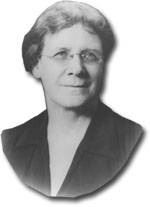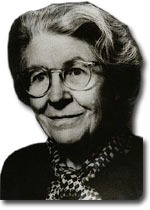
Katharine Cook Briggs
(1875-1968) |

Isabel Briggs Myers
(1897-1980) |
The MBTI®
About the MBTI
The MBTI, or Myers-Briggs Type Indicator, is a personality inventory designed to make C.G. Jung's theory of psychological types practical and useful in people's lives. It deals with what are considered natural personal preferences, not pathologies.
Isabel Briggs Myers and her mother, Katharine Cook Briggs, were the original developers of the MBTI commencing in 1942, and following almost two decades of study and observation. Since their deaths, others have carried on their work and the MBTI is being continually researched and developed.
The MBTI has been used effectively with individuals, groups and organisations throughout the world (there are a number of translations). There are a wide range of applications, including careers, communication, conflict resolution, counselling, management and leadership, relationships, teaching and learning, teamwork, personal and spiritual development etc.
MBTI Information
The MBTI, or Myers-Briggs Type Indicator, is a personality inventory designed to make C.G. Jung's theory of Psychological Types practical and useful in people's lives. It deals with what are considered natural preferences, not pathologies.
Isabel Briggs Myers and her mother Katharine Cook Briggs are the original developers of the MBTI. Since their deaths, others have carried on their work.
There are various MBTI Forms. They all present a series of forced-choice questions, in phrase and word pair format. Each question, or item, relates to a preference one of 4 sets of psychological opposites:
- Extraversion-Introversion
- Sensing-Intuition
- Thinking-Feeling
- Judgement-Perception
The 4 scales on the MBTI represent these opposites. They do not claim to say everything about these opposites.
The MBTI is a sorting mechanism for psychological preferences, not a measure of skills or abilities. Scores on the MBTI are like votes for one side or another, where each option is considered good, or valuable. People completing the MBTI can leave out questions where they like neither or all of the options presented. Isabel Myers didn't want you to give false data about preferences.
Clarity of preference on a scale relates to a level of confidence that the result is correct for the person completing it. Scores are therefore not related to any notion of development, or lack of development.
What is the MBTI used for?
The MBTI is used effectively with individuals, groups and organisations throughout the world (there are a number of translations). There are a wide range of applications, including Careers, Communication, Conflict Resolution, Counselling, Management and Leadership, Relationships, Teaching and Learning, Team Development, Personal and Spiritual Development.
Who can use the MBTI?
Not everyone can use the MBTI. Its publisher, CPP Inc, has approved MBTI Qualifying Workshops to train eligible people to correctly understand and use it at a fundamental level.
I taught one of these courses from 1993 to 2006 until it was discontinued.
In most countries, legislation allows registered psychologists to purchase and use the MBTI (and any other psychological instrument) without completing an approved workshop.
You need to check the expertise of anyone giving you the MBTI. It takes time and effort, and extra study to understand how to use it properly.
What's the best way to complete the MBTI?
Completing the MBTI is always a combination of answering the questions in a relaxed/non-pressured environment and then receiving feedback from someone qualified to do so.
Completion also involves being given appropriate instruction beforehand which should include statements like
- The questions are about natural preferences, not pathologies
- Preference is also not skill
- Don't answer the questions situationally, look for a natural response
- You can leave out questions you don't wish to answer, or wish to give both answers
What is MBTI Feedback?
Feedback is expected to be face to face discussion on the results of taking the MBTI.
Providing a printout or report and leaving at that is considered inappropriate and unethical, and completing the MBTI yourself and reading the results is considered insufficient.
Feedback involves an explanation of each of the 4 sets of preferences to enable a self-rating before the results are presented.
The purpose of feedback is not to validate the results but to establish a person's natural preferences.
Feedback must include an explanation of the processes of type dynamics and development in the context of individual results.
Giving the person booklet or publication describing the 16 types and basic type theory is also required.
The MBTI is also available on the Internet, in controlled sites approved by the publisher, where, for a fee, your results are sent to a qualified professional for examination and feedback.
Where can I find the MBTI on the Internet?
The MBTI is available only on controlled sites approved by the publisher CPP Inc. For information, go to www.mbti.com, or www.capt.org
Some questionnaires advertise themselves on the Internet as MBTI-like or Jungian questionnaires that have 4 scales like the MBTI.
These are not the MBTI, just questionnaires using the same idea, often without regard to key parts of Jung's ideas.
The MBTI has specific questions that are copyright, and so unable to be used in other instruments or questionnaires. Also the research associated with the MBTI relates only to those questions and legitimate MBTI Forms.
How can I tell the difference between the MBTI and other similar questionnaires?
If the questionnaire is generally available, then that's a key indication that it's not the MBTI. Additionally, there are other cues:
- The MBTI doesn't have any questions that ask you to select
- Yes or No
- True or False or
- to rate your answer on a 5 or more point scale (usually called a Likert scale)
- Extroversion is used instead of Extraversion
- The word emotion is used in a question, or in descriptions emotion is used almost interchangeably with Feeling. In the MBTI, Feeling is simply a style of decisionmaking, and not emotions at all.
- Number of questions. The MBTI has a minimum of 93 questions
- The MBTI also isn't available in card-sorts or as part of career development packages.
Following are individual papers on the MBTI:
What is the MBTI?
Perception and Judgement - Isabel Myers, measuring type, and the MBTI Step III Manual (241kb PDF)
On "Personality" - ICISTS Conference KAIST Daejeon Korea 17 July 2008 (100 kb PDF)
Identifying the MBTI (36 kb PDF)
Questions about the MBTI
C.G.Jung and the MBTI (16 kb PDF)
Type Descriptions (4 kb PDF)
Type Dynamics: what the MBTI indicates (16 kb PDF)
Using the MBTI
People and Qualities: The nature and type of participants in an Australian MBTI® Qualifying Workshop (660 kb PDF)
Naturally Different: from the Australian Career Practitioner
Measurement and the MBTI
Understanding the meaning of out-of-pattern scores from the Myers-Briggs Type Indicator (Form K), using type dynamics theory (24 kb PDF)
MBTI History - General
An MBTI History
Significant Dates - An MBTI Timeline
Jung and the MBTI as Science: an historical and cultural view
Thesis: Quantifying Jung - The origin and development of the Myers-Briggs Type Indicator
MBTI History - People
Why is the future that's so clear to me so opaque to you?...and other issues. Mary McCaulley in Conversation (192kb PDF)
How did I get into this??? The Otto Kroeger Interview (44kb PDF)
MBTI® and Myers-Briggs Type Indicator® are registered trademarks of the Myers-Briggs Type Indicator Trust in the United States and other countries
|